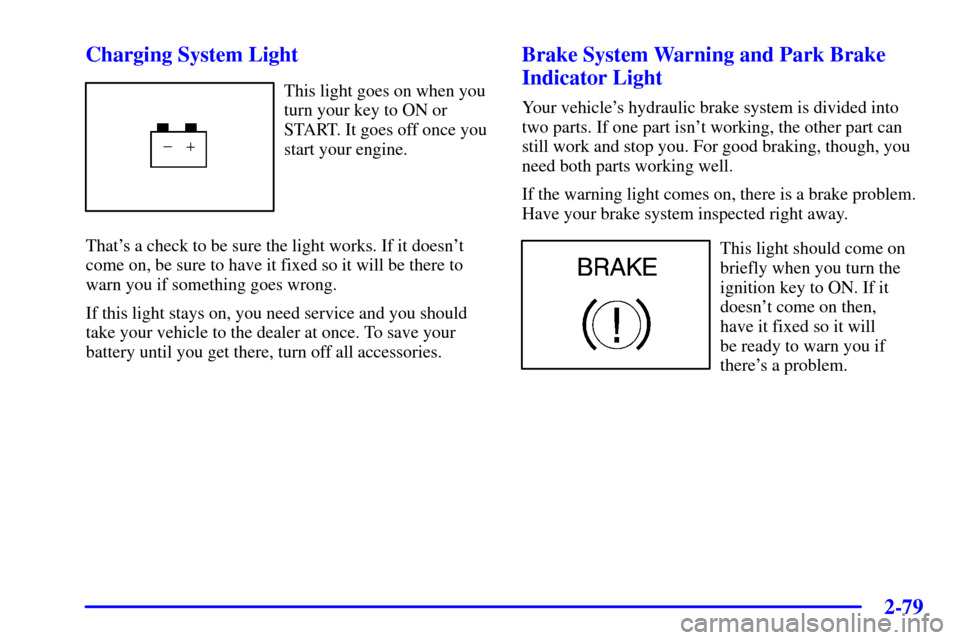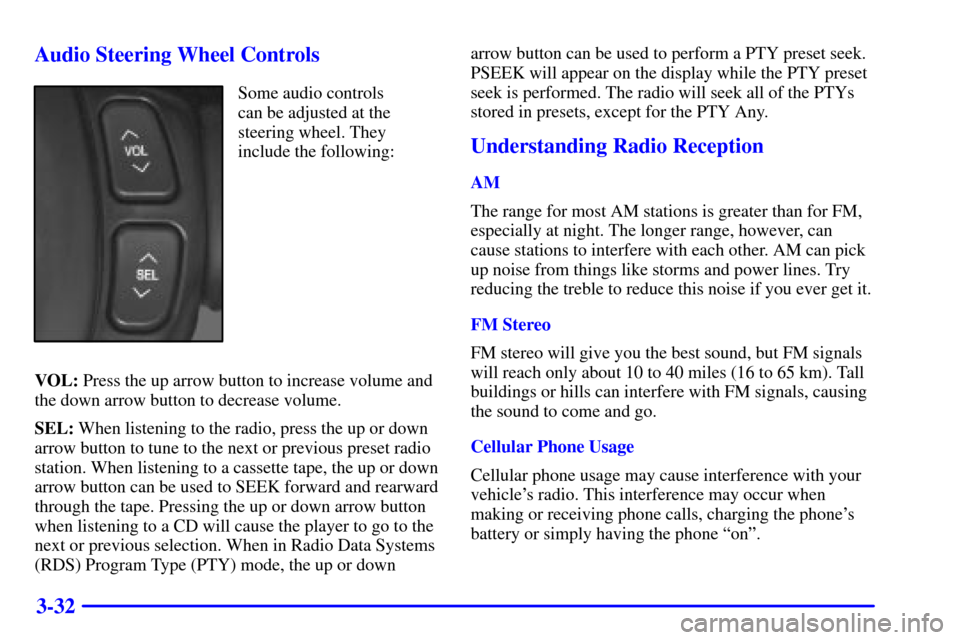2001 CADILLAC SEVILLE charging
[x] Cancel search: chargingPage 11 of 371

ix
For example,
these symbols
are used on an
original battery:
CAUTION
POSSIBLE
INJURY
PROTECT
EYES BY
SHIELDING
CAUSTIC
BATTERY
ACID COULD
CAUSE
BURNS
AVOID
SPARKS OR
FLAMES
SPARK OR
FLAME
COULD
EXPLODE
BATTERY
These symbols
are important for
you and your
passengers
whenever your
vehicle is driven:
CHILD
RESTRAINT
TOP STRAP
ANCHOR
DOOR LOCK
UNLOCK
FASTEN
SEAT
BELTS
POWER
WINDOW
AIR BAG
These symbols
have to do with
your lamps:
MASTER
LIGHTING
SWITCH
TURN
SIGNALS
PARKING
LAMPS
HAZARD
WARNING
FLASHER
DAYTIME
RUNNING
LAMPS
FOG LAMPS
These symbols
are on some of
your controls:
WINDSHIELD
WIPER
WINDSHIELD
WASHER
WINDSHIELD
DEFROSTER
REAR
WINDOW
DEFOGGER
VENTILATING
FAN
These symbols
are used on
warning and
indicator lights:
ENGINE
COOLANT
TEMP
BATTERY
CHARGING
SYSTEM
BRAKE
COOLANT
ENGINE OIL
PRESSURE
ANTI-LOCK
BRAKES
Here are some
other symbols
you may see:
FUSE
LIGHTER
HORN
FUEL
Vehicle Symbols
These are some of the symbols you may find on your vehicle. Also see ªWarning Lights and Gagesº in the Index.
Page 146 of 371

2-79
Charging System Light
This light goes on when you
turn your key to ON or
START. It goes off once you
start your engine.
That's a check to be sure the light works. If it doesn't
come on, be sure to have it fixed so it will be there to
warn you if something goes wrong.
If this light stays on, you need service and you should
take your vehicle to the dealer at once. To save your
battery until you get there, turn off all accessories.
Brake System Warning and Park Brake
Indicator Light
Your vehicle's hydraulic brake system is divided into
two parts. If one part isn't working, the other part can
still work and stop you. For good braking, though, you
need both parts working well.
If the warning light comes on, there is a brake problem.
Have your brake system inspected right away.
This light should come on
briefly when you turn the
ignition key to ON. If it
doesn't come on then,
have it fixed so it will
be ready to warn you if
there's a problem.
Page 159 of 371

2-92
Driver Information Center (DIC) Messages
These messages will appear if there is a problem sensed
in one of your vehicle's systems. Vehicles that are first
sold in Canada will have a number after each message.
This number helps to identify the problem. You must
then press INFO or INFO RESET to clear the display
screen for further use. However, be sure to take any
message that appears on the display screen seriously
and remember that pressing the INFO or INFO
RESET button will only make the message disappear,
not the problem.
Most messages can be removed from the display by
pressing the INFO or INFO RESET button while the
message is being displayed.
DIC messages can also be displayed in French, German,
Spanish and Japanese. Contact your dealer to have the
language display adjusted for your vehicle.
BATTERY NOT CHARGING
- 7: This message will
appear if the battery is not being charged. Have the
electrical system checked by your dealership at your
earliest convenience.BATTERY SAVER ACTIVE
- 27: This message
is displayed when the vehicle has detected that the
battery voltage is dropping beyond a reasonable point.
The battery saver system will start reducing certain
features of the vehicle that you may not be able to
notice. At the point that features are disabled, this
message is displayed. It means that the vehicle is trying
to save the charge in the battery. Turn off unnecessary
accessories to allow the battery to recharge.
BATTERY VOLTAGE HIGH
- 8: This message
shows that the electrical charging system is
overcharging (more than 16 volts). To avoid being
stranded, have the electrical system checked by your
dealership. You can reduce the charging overload by
using the accessories. Turn on the lamps and radio, set
the climate control on AUTO and the fan speed on HI,
and turn the rear window defogger on. You can monitor
battery voltage on the DIC by pressing the INFO button.
The normal range is 11.5 to 15.5 volts when the engine
is running.
Page 160 of 371

2-93
BATTERY VOLTAGE LOW - 6: This message will
appear when the electrical system is charging less than
10.5 volts or if the battery has been drained. If this
message appears immediately after starting, it is possible
that the generator can still recharge the battery. The
battery should recharge while driving but may take a
few hours to do so. Consider using an auxiliary charger
(be sure to follow the manufacturer's instructions) to
boost the battery after returning home or to a final
destination. If this message appears while driving or
after starting your vehicle and stays on, have it checked
immediately to determine the cause of this problem.
To help the generator recharge the battery quickly, you
can reduce the load on the electrical system by turning
off the accessories. You can monitor battery voltage on
the DIC by pressing the INFO button. The normal
range is 11.5 to 15.5 volts.
CHANGE BRAKE PADS
- 125: This message is used
to notify you that the brake pads may have worn down.
A sensor is connected to the brake pads and is triggered
when they wear to a certain point. Have the front and
rear brakes serviced by your dealer as soon as possible.CHANGE ENGINE OIL
- 82: This means that the
life of the engine oil has expired and it should be
changed within 200 miles. See ªEngine Oilº and ªFilter
Recommendationsº in the Maintenance Schedule
booklet. After an oil change, the Oil Life Indicator must
be reset. See ªOil Life Indicator, How to Resetº in
the Index.
CHANGE TRANS FLUID
- 47: This message will
appear when it is time to replace the transaxle fluid.
See the Maintenance Schedule booklet for the proper
fluid and change intervals.
CHECK BRAKE FLUID
- 37: This message will
display if the ignition is in ON to inform the driver that
the brake fluid level is low. Have the brake system
serviced by a technician as soon as possible. See ªBrake
System Warning Lightº in the Index.
CHECK COOLANT LEVEL
- 2: This message
will appear when there is a low level of engine coolant.
Have the cooling system serviced by a technician as
soon as possible.
Page 164 of 371

2-97
PASSENGER DOOR AJAR - 141: The passenger's
door is open or ajar when this message appears.
The ignition must be in ON and the transaxle not in
PARK (P) for this message to display. A chime will
also sound when the vehicle's speed is greater
than 3 mph (4.8 km/h).
RIGHT REAR DOOR AJAR
- 143: The right
rear door is open or ajar when this message appears.
The ignition must be in ON and the transaxle not in
PARK (P) for this message to display. A chime will
also sound when the vehicle's speed is greater
than 3 mph (4.8 km/h).
SERVICE AC SYSTEM
- 14: This message appears
when the electronic sensors that control the air
conditioning and heating systems are no longer working.
Have the climate control system serviced if you notice a
drop in heating and air conditioning efficiency.
SERVICE AIR BAG
- 83: There is a problem with the
supplemental inflatable restraint (air bag) system when
this message appears. Let only a qualified technician
work on your vehicle. See your dealership for service
at once.SERVICE CHARGING SYS
- 102: This message
will display when a problem with the charging system
has been detected. Have your vehicle serviced at
your dealership.
SERVICE ELECTRICAL SYS
- 106: This message
will display if an electrical problem has occurred within
the Powertrain Control Module (PCM) or the ignition
switch. Have your vehicle serviced by your dealership.
SERVICE FUEL SYSTEM
- 101: The Powertrain
Control Module (PCM) has detected a problem within
the fuel system when this message appears. See your
dealership for service.
SERVICE IDLE CONTROL
- 107: A problem with
the idle control has occurred when this message displays.
Take your vehicle to your dealership for service.
SERVICE STABILITY SYS
- 54: If you ever see
the SERVICE STABILITY SYS message, it means
there may be a problem with your stability enhancement
system. If you see this message, try to reset the system
(stop; turn off the engine; then start the engine again).
If the SERVICE STABILITY SYS message still
comes on, it means there is a problem. You should see
your dealer for service. Reduce your speed and drive
accordingly. A single chime will also sound when this
message is displayed.
Page 211 of 371

3-32 Audio Steering Wheel Controls
Some audio controls
can be adjusted at the
steering wheel. They
include the following:
VOL: Press the up arrow button to increase volume and
the down arrow button to decrease volume.
SEL: When listening to the radio, press the up or down
arrow button to tune to the next or previous preset radio
station. When listening to a cassette tape, the up or down
arrow button can be used to SEEK forward and rearward
through the tape. Pressing the up or down arrow button
when listening to a CD will cause the player to go to the
next or previous selection. When in Radio Data Systems
(RDS) Program Type (PTY) mode, the up or downarrow button can be used to perform a PTY preset seek.
PSEEK will appear on the display while the PTY preset
seek is performed. The radio will seek all of the PTYs
stored in presets, except for the PTY Any.
Understanding Radio Reception
AM
The range for most AM stations is greater than for FM,
especially at night. The longer range, however, can
cause stations to interfere with each other. AM can pick
up noise from things like storms and power lines. Try
reducing the treble to reduce this noise if you ever get it.
FM Stereo
FM stereo will give you the best sound, but FM signals
will reach only about 10 to 40 miles (16 to 65 km). Tall
buildings or hills can interfere with FM signals, causing
the sound to come and go.
Cellular Phone Usage
Cellular phone usage may cause interference with your
vehicle's radio. This interference may occur when
making or receiving phone calls, charging the phone's
battery or simply having the phone ªonº.